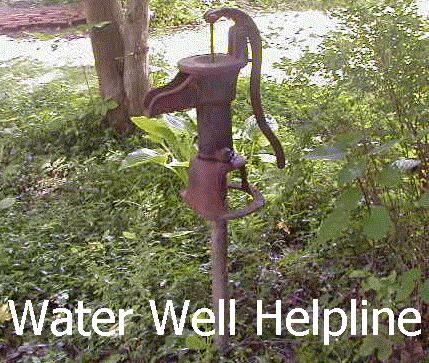
An Inexpensive, Do-It-Yourself, Small Diameter Water Well
Having Problems? Need advice? Try the Water Well Helpline Message Board.

If you can drive a nail into a board, you have the skills to augment your water supply. Drilling companies charge thousands of dollars to tap ground water sources that you can often reach yourself with a few common tools and about two weekends of work.
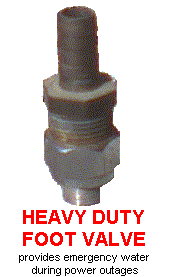 You'll need a 2-inch drivepoint with screen (a hollow, conically shaped metal point adjoined to a fine mesh screen), several spools of teflon tape, 2-inch galvanized couplings to attatch pipe lengths together, 5-foot-long threaded lengths of 2-inch galvanized Schedule 40 pipe, 2-inch galvanized caps for the pipe, concrete mix, a weight, a foot valve, and 85 feet of 1/2 inch inside diameter, thick-walled, flexible, UV resistant, flexible polyethylene tubing (I used Toro "funny pipe" irrigation tubing).
You'll need a 2-inch drivepoint with screen (a hollow, conically shaped metal point adjoined to a fine mesh screen), several spools of teflon tape, 2-inch galvanized couplings to attatch pipe lengths together, 5-foot-long threaded lengths of 2-inch galvanized Schedule 40 pipe, 2-inch galvanized caps for the pipe, concrete mix, a weight, a foot valve, and 85 feet of 1/2 inch inside diameter, thick-walled, flexible, UV resistant, flexible polyethylene tubing (I used Toro "funny pipe" irrigation tubing).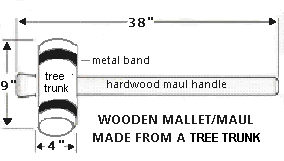 Hit the capped pipe as evenly as possible in the center of the cap and avoid side-to-side swaying of the pipe. A well-placed blow will make a dull sound rather than a ping. When the cap becomes cracked or dented, discard it and screw on a new one. Establish a steady rhythm and the work will go easier. When the cap is about even with the bottom of the pit, unscrew it and screw on a coupling and a new length of pipe. Use teflon tape on the pipe threads, and make certain all connections are tightened securely with a pipe wrench. You may occasionally need to work from a step ladder in order to reach the cap with the maul. When going through clay or shale, you may find it easier to use a sledgehammer, but be careful not to overdo it.
Hit the capped pipe as evenly as possible in the center of the cap and avoid side-to-side swaying of the pipe. A well-placed blow will make a dull sound rather than a ping. When the cap becomes cracked or dented, discard it and screw on a new one. Establish a steady rhythm and the work will go easier. When the cap is about even with the bottom of the pit, unscrew it and screw on a coupling and a new length of pipe. Use teflon tape on the pipe threads, and make certain all connections are tightened securely with a pipe wrench. You may occasionally need to work from a step ladder in order to reach the cap with the maul. When going through clay or shale, you may find it easier to use a sledgehammer, but be careful not to overdo it.

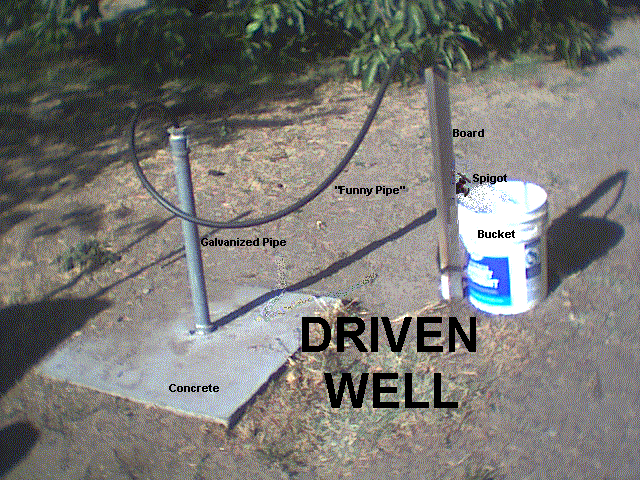
If you have indoor plumbing or sprinklers, you will need a powered pump. Should the flow and/or pressure prove insufficient, you can either hook up multiple wells in series or install a storage tank. Inexpensive solar powered pumps are available, but I cannot vouch for their dependability.

 one 2 inch diameter drivepoint with screen (from well supply dealer), $80
one 2 inch diameter drivepoint with screen (from well supply dealer), $80 two spools teflon pipe thread tape, $2
two spools teflon pipe thread tape, $2 fifteen 2-inch galvanized couplings, $68.70
fifteen 2-inch galvanized couplings, $68.70 fifteen 5-foot threaded lengths of 2-inch galvanized Schedule 40 pipe, $140
fifteen 5-foot threaded lengths of 2-inch galvanized Schedule 40 pipe, $140 five 2-inch galvanized caps, $14.45
five 2-inch galvanized caps, $14.45 two bags concrete mix, $6
two bags concrete mix, $6 one 2-ounce weight, $1
one 2-ounce weight, $1In 1991, I drove a 67 foot deep, 1 1/4 inch diameter well in my backyard. To my utter dismay, they no longer made a pump that would fit this type of well. I could either salvage a manual pump from an old well (a complicated assembly with a push rod and leathers) or come up with my own design. Thus, the inertia pump was born of necessity. Although it will pump any size of well, it works exceptionally well with 1 1/4 inch diameter deep wells and off-center or slanted wells.
Since inertia pumps contain only one moving part and are constructed from durable materials, they are extremely reliable. They work in situations where more sophisticated pumps fail and do not lose their prime. Inertia pumps are ideal for supplying campgrounds and cabins, bringing in new wells (nothing will cause a powered pump to seize up faster than pumping dirty water), or for emergency water in case there is a power outage. Unfortunately, inertia pumps do not produce a sufficient rate of flow or enough water pressure to supply sprinkler systems and indoor plumbing.
You will need the following to build an inertia pump: a 1/2 inch diameter solid brass or stainless steel ball salvaged from a ball bearing, a brass 1/2 inch male pipe threads by 1/2 inch inside diameter barb, a brass 1/2 inch female pipe threads by 1/2 inch brass tube fitting (discard insert, nut, and sleeve), and two 1/4L neoprene washers (all three fittings can be purchased at a nearby plumbing supplies retailer—total cost, approximately $5). You will also need a 100 foot roll of 1/2 inch inside diameter, UV resistant tubing (available from the plumbing department at a warehouse building supplies retailer).
There are two types of brass 1/2 inch female pipe threads by 1/2 inch compression fittings—one has a flat inside and the other has a beveled inside. In order for the solid metal ball to seat properly, the inside of the this compression fitting MUST be beveled. Otherwise, it will not work.
Carefully enlarge the holes in the neoprene washers until they are 3/8 inch in diameter with a file or a rasp.Push the washers into the large end of the hose barb until they fit snugly (if they don't fit snugly, try using 3/8 or 3/8M washers). Wrap the male pipe threads with teflon tape. Place the 1/2 inch metal ball on top of the washers. Next, screw the two brass fittings onto each other. The device you put together is called a foot valve. If you assembled it correctly, the metal ball will rattle when you shake the valve.
Because the only thing standard in brass plumbing fixtures are the threads, some adjustment may be necessary to achieve maximum flow. Cut a foot long piece of tubing, rub the inside edge with vaseline, and push it gently onto the hose barb. Next, grasp the top of the tubing while jerking the foot valve up and down in a bucket of water. Count the number of strokes it takes before water flows out the top of the tubing. Now, unscrew the foot valve by one full turn and repeat the experiment. Try it again after removing one of the neoprene washers. The fewer strokes it takes, the better the adjustment.
Foot valves are one way check valves that operate on the principle of inertia, allowing water to enter the 1/2 inch inside diameter tubing during the down stroke, but preventing it from draining back into the well on the up stroke. Together, the valve and tubing form an inertia hand pump that requires little or no maintenance. Should it ever become clogged with sand or silt, the foot valve easily screws apart for cleaning. Using this system, it takes approximately 15 minutes labor to pump 5 gallons of water from a depth of 65 feet.
Now that you have adjusted the foot valve, it is time to assemble the inertia pump. Shove one end of the tubing securely onto the barbed end of the foot valve. If you have done this properly, it won't come off when you tug on it. Your well should extend approximately two feet above ground level and should end in female threads. If it ends in male threads, screw on a coupling. Purchase a 1/2 inch galvanized bushing that is the same diameter as your well. But before you screw it on, use a small rasp or a file to get rid of the 1/2 inch threads from the hexagonal end of the bushing. Polish them smooth. Now wrap the threads on the large end with teflon tape and stick the free end of the tubing through the 1/2 inch hole. Lower the foot valve down the well and screw the galvanized bushing onto the female threads at the top of the well. Next, drive a 2 inch by 3 or 4 inch wooden board into the ground 36 inches from the well. Form a 7 to 8 foot loose loop (see photo of driven well) and attatch the tubing to the board with a 1/2 inch pipe clamp fastened with wood screws. Detatch any excess tubing with a knife or a box cutter so that the end is high enough to place a bucket underneath. Use a hose clamp to attatch a spigot (this keeps insects out of the well).
Using an inertia pump is akin to churning butter or clearing a drain with a plunger. Imagine the well to be a batter's box and take a comfortable stance. Reach out and grasp the tubing firmly in both hands at approximately the level of your waist. Lift the foot valve off the bottom of the well and begin to jerk the tubing rapidly up and down, being careful to avoid contact between the foot valve and the bottom of the well. At first, it might take as much as 200 strokes before water starts to flow from the open end of the tubing. However, if there are no leaks, the inertia pump will remain primed and it should be easier the next time around.Adding a counterweight connected to the inertia pump by a rope and two pulleys will make pumping less difficult. Use a canvas bag filled with sand for a counterweight and subtract sand until the bag weighs slightly less than the weight of the inertia pump when it contains water. Adjust the amount of sand in the bag until you can pull the bag down without difficulty and have it return to the up position when you let go.
Jet Pumps A Jet pump is a combination of two pumps, the injector jet and a centrifugal (diffuser) pump that is used to draw water from wells into residences. If the jet is located in the pump itself, it is known as a shallow well pump and will lift water up to about 25 feet. If the jet is located down in the well below the water level, then it is a deep well pump and can lift water between 25 and 120 feet when installed properly. Jet pumps utilize an impeller mounted on the drive shaft that spins and thrusts the water from the inlet to the outlet pipe similar to a centrifugal pump but at increased pressure. At the inlet nozzle, before the water reaches the impeller, it passes through a venturi, which is a tapered constriction in the pipe. As the water passes through this constriction, it builds pressure and the velocity of the water increases. As the water is released into the widening section of the venturi, pressure drops, creating a suction effect at the constriction, and increasing the flow of water into the pipe. A diffuser following the mixing chamber slows down the water and converts velocity head into pressure head.
Jet pumps are self-priming, have no moving parts and do not require lubrication. Their efficiency is lower than that of a submersible pump (on average about 40 percent). Jet pumps typically provide low rates of flow at high pressure. Since the motors are above the water, jet pumps are easier to service than submersibles.
Pressure Tanks
If you can't take a shower and do the laundry at the same time without running out of water, you should think about getting a pressure tank. The pressure tank fills at times when you are not using water and stores it for when you need it. By having a tank of air pressurized to the level of your interior plumbing, you have a reserve of pressure that lets the water pump run less often. In the event of a power outage, you will be able to draw a few gallons of water before the system goes dry. Also, the air in the tank cushions surges, resulting in a smoother flow of water from your fixtures.
There are two types of pressure tanks. Many older homes use a simple single-compartment tank which holds both air and water. These tanks have a standard bicycle-type air valve for adding air. Newer homes usually have a tank with an internal bladder. This bladder is like a balloon filled with air, which keeps air and water separate. To find out if a bladder has gone bad, depress the inflation valve (it is usually located on the side of the tank somewhere near the top). If water comes out, the bladder has ruptured and you will need to replace the tank.
With time, the air in a single-compartment tank will be absorbed by the water. As the amount of air in the tank decreases, the tank looses its ability to hold pressure, and the well pump on-off cycle time decreases until the pump cycle causes surging at the fixtures. This continuous running can potentially damage your pump and shorten its life. Years worth of wear and tear can occur in a matter of days as your pump cycles on and off without letup while attempting to maintain pressure in your water system.
In order to recharge a bladderless well tank, the tank must be completely drained of water. You may need to use an air compressor to blow the air out of the tank if your tank in below grade without a convenient drain. Here is how to do it. First turn off the well pump switch or flip the circuit breaker. Then, turn on a spigot that is above the level of the tank to let the pressure out of the system. Attach the compressor hose to the air valve on the pressure tank and pump air into it. When air begins to come through the open spigot, detatch the compressor. Turn on your well pump and the tank will be automatically pressurized. Close the faucet after the air is exhausted from the system. You may experience sudden spurts of air from faucets and toilets for a short time as the system relieves itself of air introduced by the partial draining of the system.
If you have a bladder-type tank, the tank should be pre-pressurized to two pounds above the low pressure setting on your pump. To adjust the pressure in a bladder-type tank, decide on the low pressure you want for your system (usually around 30 psi) and add or subtract air via the inflation valve.Water Pressure
Your pump determines your water pressure. New homes have to meet certain guidelines with regards to pressure and flow. Your indoor plumbing should be 3/4" minimum until the point where it branches off to the fixture at which point 1/2" is permitted. Usually there is a discharge/shutoff valve just after the pressure tank. Most new homes come with a 30/50 pressure switch, which means the pump turns on when the pressure in the tank reaches 30 psi, and turns off when the pressure reaches 50 psi. If you feel you need more pressure, turn off the circuit breaker, take the cover off the switch, and then use a wrench to tighten the large nut (which compresses the spring) until the pump reaches a 40/60 on/off ratio as shown by the pressure gauge. If you attempt to set it any higher than 60, you do so at your own risk.
How to Make a Drivepoint from Pipe
You can make a drivepoint from pipe. Here is how:
1. Flatten the end of the pipe to a gradual taper similar to the working end of a cold chisel.
2. Cut a V-shaped notch out of the flattened end.
3. Bring the two points together to form a single point.
4. Weld the two sides of the point together.
5. File off any burrs or irregularities.
Alternatively, a point may be cast from iron and welded to the end of pipe. It should have an edge on the back of the point which butts securely against the end of the pipe. So as to prevent damage to the pipe couplings, make the largest diameter of the point greater than that of the pipe couplings.
To make the wellscreen, either drill holes of the desired screen size (if you aren't sure what size you need, 1/100 inch will screen out sand) or by making a series of short diagonal hacksaw cuts. When you make the openings, keep in mind that strength must be retained in the pipe or it won't withstand driving. This can best be assured, in the case of the saw cuts, by leaving several longitudinal strips unperforated. An alternative method would be to cut larger openings and then cover them with wire mesh of the desired screen size soldered around the pipe. The screening should be protected from being slit or stripped back when the point is driven into the ground. You can do this by (a) wrapping and soldering sheet metal with coarse perforations around the screening and (b) making it so that either the point or a collar attached to the pipe below the screen will have an outside diameter greater than the outside diameter of the screening.
New Life for Old Wells
Nothing is more frustrating than having a well go dry. Usually, all it would take to make your well good again is to go ten or fifteen feet deeper, but most drillers prefer to drill a new well which can easily cost a month's wages or more.
This is where a drivepoint can save the day. Given the proper conditions, you can lower a drivepoint (also called a sandpoint or a wellpoint, depending on where you are from) to the bottom of a dry cased well and drive it down until you hit water. Chances are you won't have to go very far.
Each well, of course, is different. But here is how Dennis Meyer went about it on some lakeshore property he bought in Brainerd, Minnesota:"This property came with a cabin and a well and is near another cabin we had owned for some time. The well consisted of a stand pump, a nice 4Ό inside diameter casing, and a 1Ό" x 3' sandpoint below the casing. It had a 3 lift cylinder down about 25 inside the casing and the previous owner said that the water table was about 37 below the surface. The casing had been installed by the previous owner in an attempt to get the point and lift cylinder down as far as possible in order to get better water.Dennis says that he would not recommend this method for everyone since it involves preassembling the components on the surface before they are put into the well. I might add that this should never be attempted in rocky soils or on water wells that are extremely deep..
With the addition of a pumpjack, this well supplied water for about 20 years, however, the water volume had recently gotten quite low. Because this was a spare cabin that we use merely for extra sleeping space I really didnt need to put in pressurized water. However, my ever-lovin wife thought I could rig something better than an outside pump. Being an electrical engineer (a real handicap here) and not knowing much about water wells, I had to resurrect my old hydrology class books, study them, talk to some experts, and then see what I could do. I started by pulling up the old point/pipe assembly with the three-point lift on my tractor and noted that the 3' point had been down approximately 41' and was heavily encrusted with calcium and magnesium—an indication of hard water. I determined that the 4Ό i.d. casing went down exactly 34. The lake is 110 from the well, the lake surface is 37 below the top of the well, and the well is 1190 above sea level. With this information, I determined that the longest distance that water could be lifted by suction would be 23', which would not be enough for my needs.
I gave it some thought and decided I would create a hybrid well, consisting of a convertible two-pipe jet pump with the injector/jet located at the bottom of the casing and driven tail pipes, a check valve, and a 5' long, 1Ό sandpoint below the jet.I would then connect the injector to the pump at the surface. Since I was planning to lower the sandpoint, tail pipes, check valve, and injector, with pressure pipe completely assembled into the casing, I decided to use only high quality components that I was sure would withstand the driving. I wanted to get the jet as close to the water table as I could to minimize lift and maximize flow. I also wanted to use 1Ό rather than 2 pipe so that I could drive it as far as possible in hopes of getting the soft water we had at the other cabin nearby. For my purposes, water quality was more important than quantity.
The trick here was to be able to drive the entire assembly down to where I thought there was soft water without damaging or breaking something and thats where the driver comes in. I found a well-made post driver at an auction. It was made from 3½ stainless pipe with a 7/16 thick wall and it was 40 long. It had two nice 1 diameter handles parallel to the driver, each about 12 long, one on each side and a Ύ thick plate welded just inside the top. This driver looks as if it was professionally made for heavy-duty post driving, however, it would be relatively easy to make one. I melted about 12 of plumbers lead inside the top of the driver. The lead is the key in that it yields a nice soft blow to preclude damage to the whole assembly. The same amount of energy is delivered to the leaded pipe that a non-leaded driver of the same weight would deliver, its just that the energy is spread out over a longer period of time. As far as the pipe threads, the check valve, and the injector are concerned, it is better to limit the shock from the blows as much as possible. A word of caution is in order. Since lead is known to be toxic, you should be careful not to let any lead drop into the well.
In order to assure that I had good strong joints, I began by assembling the drivepoint, the tail pipes, the check valve, the injector, and the pressure pipe at the surface using Teflon tape. For added strength, I used drive couplings. Of course, I was careful not to get any foreign material into the system that might plug up the jet. I lowered this assembly down into the casing using clamps made from 5/16" x 1Ό strap steel and 3/8" bolts to fasten the straps to either side of the pipe. Being careful not to let it drop, I lowered the assembly into the casing and, when the injector/jet with a clamp below it rested on the top of the casing, I added 10' sections of Schedule 40 galvanized pipe above the jet until the point reached sand at 35'. I was then able to drive the whole assembly, adding 1Ό pipe as needed until the drivepoint reached a depth of 50. Even though I had a 35' head start and the able assistance of my friend, Hugh McMillan, it took time and patience to get the assembled components to a depth of 50' without shaking something loose.
From bottom up, starting at 50, I have the following: 5 stainless steel drivepoint, 5 section of galvanized pipe, stainless steel check valve, 5 section of galvnaized pipe, in-line injector with 20-90 depth nozzle and venturi. [The injector lies near the bottom of the casing.] Then there is 35 of 1" Schedule 40 PVC pressure pipe, and 35 of Schedule 40 galvanized steel suction pipe (three 10 sections and one 5 section). The plastic pipe and the 1Ό galvanized pipe continue up through the casing and connect with the ½ hp pump near the surface. I used a Red Lion injector becuase it puts the tail and riser pipes in-line to avoid damage during driving and they are also quite tough. The pump is a ½ horsepower Red Lion. Both pump and injector are made by Monarch Industries in Winnipeg, Manitoba, and can be purchased at farm and ranch supply stores. Drive couplings and a stainless steel check valve are sold by plumbing stores and/or well supplies dealers.
I talked to several well drillers and pump experts before I started and none of them had ever heard of anyone doing this but thought it would work and encouraged me to try. I tried it and this setup really works."
A drivepoint can also be used to rehabilitate a dug well. Lower the drivepoint to the bottom of the well and brace the galvanized pipe at the top with timbers. When you have finished, make a sturdy cover to keep contaminants out.
Dug Wells
You can't get much simpler than a dug well. It is little more than a hole in the ground. When lined with brick, stone, sewer pipe, or some other impervious material, the section that is below the groundwater level should have openings to permit water to enter from the aquifer. To avoid contamination from surface runoff, the walls of the well should extend above the surface and a cover or roof should be added.
A dug well actually has a few advantages over other types of wells. Only simple hand tools—a pick and a shovel—are required. Also, the well acts as its own reservoir, eliminating the need for a storage tank. Since the diameter is larger than other types of wells, the flow rate will be greater (for every 100 percent increase in the diameter of a well, the amount of water entering the well at any given moment—the rate of flow—will increase by approximately ten percent).
Even experienced construction workers are sometimes trapped when the walls of an excavation collapse. For safety's sake, never enter a hole deeper than your waist without bracing the sides. One of the easiest and least expensive ways of shoring up a well is to use concrete sewer pipe. Choose a diameter that will allow you to swing a pick from the inside without hitting the walls. Place the first section upright on the ground where you want the well. You will need two ladders—one to climb to the top of the pipe and the other to get to the bottom. Use the shovel to undermine the pipe. As you clear away the dirt from beneath the pipe, its considerable weight will cause it to settle. This works best if you dig a few inches beyond the outer edge of the pipe. Be careful—don't ever put your feet or fingers beneath the pipe. The more you dig, the farther it will sink. When the top of the pipe is even with the ground, slide another section of pipe on top. Keep this up until you reach water, then go down several more feet to compensate for seasonal fluctuations in the water table. Cut a few openings in the bottom section of pipe to enable groundwater to enter your well. The final step is to pack the last foot or so of the well with a thin layer of stones and pebbles followed by a thick layer of gravel.
Disposing of the dirt can be a problem. Hauling dirt up with a bucket on a rope is hard labor. Fashion a temporary tripod with a pulley at the top of the well and you will make faster progress. The volume of dirt you will have to haul away is liable to be greater than you would guess.Dug wells have been around since ancient times. The Old Testament twice mentions the well of Bethlehem, located by the city gate (Samuel 23:15 and 1 Chronicles 11:17). Many of these wells—some of which are still in use today—were dug at an incline with wide, elongated stone steps leading gently down to an underground chamber at the bottom of which there was a subterranean pool of water. Jars and pitchers were filled with water at the edge of the pool and balanced on the head on the way up. Such wells are only practical in arid climates where there is not much risk of contamination from surface runoff.
Augured Wells
Augering a well resembles boring a hole in wood or laminate with a drill. As it rotates, the cutting edge of the auger shaves off a small piece of soil which feeds upward and is emptied when you remove the auger from the hole. There are both small diameter hand augers and large diameter powered augers. Auger attatchments are available for backhoes, tractors, and excavators. By utilizing extensions, it is possible to bore down to the water table in almost any strata with the exception of bedrock. This type of well has to be cased with a pipe that is smaller than the hole. Sand, silt, and decomposed granite are unlikely candidates for augering because the hole tends to collapse when the auger is extracted. Once the water table is reached, some other method—such as a drivepoint—has to be used to get any deeper since it is impossible to bore a sustainable hole in saturated soil.
In addition to helical augers, there are various other types of earth augers such as the bucket auger (more commonly known as a post hole digger) and the tubular auger, which consists of a long hollow slotted pipe with teeth cut into the bottom end. A tubular auger has to be shoved into the ground on the end of a rod and twisted in order to accomplish its task. This kind of auger works well in almost any sort of clay.Sprinkler Systems
If you have municipal water and your monthly bill is more than you can afford to pay, you might want to consider switching to a drivepoint for your irrigation water. Where I live (Riverside County in Southern California), the county charges less for irrigation well permits than it does for potable water permits. Vegetable gardens, trees, flowering plants, and lawns often thrive on water that is less than pristine. Most sprinklers require at least 40 psi. The more pressure you can develop, the better. If you have a lot of sprinklers, you will need to build a manifold and purchase a station timer. Install a check valve just before the pump. This will prevent the water from draining back into the well when the pump is off. If the output of the pump is less than the volume of water required to run the sprinklers, a big enough pressure tank will make up the difference. Subtract the gallons of water that the pump produces from the number of gallons required by your sprinklers and the remainder is how big your tank should be.
Developing Your Well
Remove sand or dirt within the well by lowering a garden hose to the bottom of the well and flushing it with water. A high-velocity stream of water loosens dirt that has become imbedded in the screen during the process of driving the point and washes the finer particles upward and out of the pipe. Backwashing under pressure may help to increase the flow of water into the well.
To cleanse your well of any particles that remain, use a foot valve at the bottom end of a long length of polyethylene tubing (it's called an inertia pump) to manually pump the water until it is silt free. The foot valve (a heavy-duty brass valve can be ordered from the author by clicking on the order button below this text) is a one-way check valve that allows water to enter the tubing as it is manually jerked up and down. Since water cannot be compressed, the water level within the tubing rises with each stroke until it exits at the top. Because even miniscule grains of sand can cause pump burnout, it is best not to use an electrically powered pump to perform this task.
Although the inertia pump cannot provide sufficient volume and pressure to operate household plumbing, its low cost, durability, and ease of maintenance make it an ideal choice wherever low pressure and volume will not pose a problem.
Ordinary vacuum pumps will not work with wells deeper than 25 feet due to the limitations of atmospheric pressure. Electrical deep-well pumps are available in cylinder, jet, and submersible types. Used or rebuilt pumps can be obtained for a fraction of the cost of a new pump. Since each well has unique characteristics which can greatly influence your choice, it is often best to wait until after the well is completed to purchase a pump.
A professional driller puts a handful of chlorine tablets in each new well to kill bacteria introduced into the aquifer during penetration. A half gallon of ordinary household bleach is the liquid equivalent and is less expensive. Pump the well immediately until the chlorine smell and taste vanishes.
If your well's volume of water is too small for your needs, two or more driven wells can be connected in a series. Adding a storage tank to your system will also help to increase its efficiency during periods of peak demand.
Commercial laboratory testing is expensive, but is advisable if your well is going to be your primary source of potable (drinking) water. However, if your well is going to be used for agricultural or irrigation purposes, there are cheaper methods to determine its worth. Acidity and alkalinity tests can be done with litmus paper or kits bought from a pool supplier. A drop of well water placed on agar in a petri dish and incubated may indicate the presence or absence of bacteria. Keeping a male beta (Siamese fighting fish) in a bowl of well water is a colorful way to test its quality.
From: Fred Dungan
From: Ronald_Fitch@SSGA.COM
Fred,
Dear Ron,
From: Kurt Mueller
From:
----- Original Message -----
From: "El Lobito"
To: fdungan@fdungan.com
Sent: Tuesday, January 29, 2002 12:24 AM
Subject: Sandpoint well.
Hi Fred,
I came across your site by miracle. I haven't had much luck in
finding any information about sandpoint wells. My parents' home has a
sandpoint well and it seems like it may of gone dry. I am planning to
see how difficult it is to install another sandpoint well myself. I
just wanted to take the time out to thank you for making this information
available. I was wondering if there are any more tips or things I should
take into consideration with a sandpoint well. I will point out that
is the only source of water for my parents' home.
Thanks for your time.
Cuco Anaya
el_lobito@onebox.com - email
From: Tim Howard
From: Peter Schmied
From: Fred Dungan
From: Nord, Russ (MED, LUNAR)
From: Fred Dungan
1. compressed airLet's take a worse-case scenario and say that you somehow put a large hole in the well screen. At least it is no longer clogged. Drop a smaller diameter Schedule 40 pipe with an inexpensive PVC drivepoint on one end down the inside of your well and you will have a slightly smaller, but more efficient well. However, this is a last resort. I would first try the compressed air and the acid.
2. chemicals
3. bullet
From: Hebert, Tim
From: Fred Dungan
From: "Allen Borlaug"
To: "Fred Dungan"
Sent: Monday, April 22, 2002 4:31 PM
Subject: Well location
Dear Fred,
I was in luck and found your article on the net. I just bought a piece
of proprerty in north Iowa and hope to install a sand point well. A new
drilled well was just put in across the road from my property and the
log of well is as follows:
0' to 9' topsoil, brown clay
9' to 20' Blue clay
20' to 45' Sandy blue clay
45'to 83' Blue clay
83' to 85' Limerock
85' to 101' Shale
101' to 118' Limerock
118' to 120' Shale
What kind of educated guess could you give me at the chances of finding
water based on this log? There is a sandpoint well that has worked
well about 1/4 mile down the road on the other side of a small stream.
Thank you for your trouble.
Sincerley yours,
Allen Borlaug
To: senatorb@powerbank.net
Sent: Monday, April 22, 2002 7:37 PM
Subject: Re: Well location
Dear Allen,
You are obviously one of those rare individuals who take the time and trouble to do the research before embarking upon a project. The well log definitely tells a tale from which you may benefit.
Let's begin with a bit of inside info on the business of drilling. It is standard practice in the drilling industry to go down at least 100 feet regardless of how much water may be bypassed at a shallower depth. The purpose of this is twofold—#1 it helps to justify the enormous cost (because the drilling rig costs upwards of $100,000, the contractor often charges thousands of dollars simply to set up his equipment at the site) and #2 the deeper the well, the less chance that it will go dry during seasonal fluctuations or droughts.
Now, let's move on to an analysis of the well log. I am surprised that the contractor did not note the depths and flow rates of any water encountered at shallower depths. Of course, it is possible (but not likely) that he did not encounter water until he reached the second layer of shale. But if he did, it would have been on top of the blue clay or limerock. I suggest that you go visit the sand point well and find out how deep it is as there is a good chance that you will find water at about the same level on your property. Don't attempt to punch through blue clay or limerock with a drivepoint as such strata is almost impossible to penetrate without a drilling rig.
Wishing you success,
Fred Dungan
From: Martin, Michael D MMC(SS) (CSS16 N405) MartinMD@css16.navy.mil
----- Original Message -----
From: Thomas Tidwell
From: Randall Reihing
From: Fred Dungan
---- Original Message -----
From: "Fred Dungan" fdungan@fdungan.com
----- Original Message -----
From: Fred Dungan

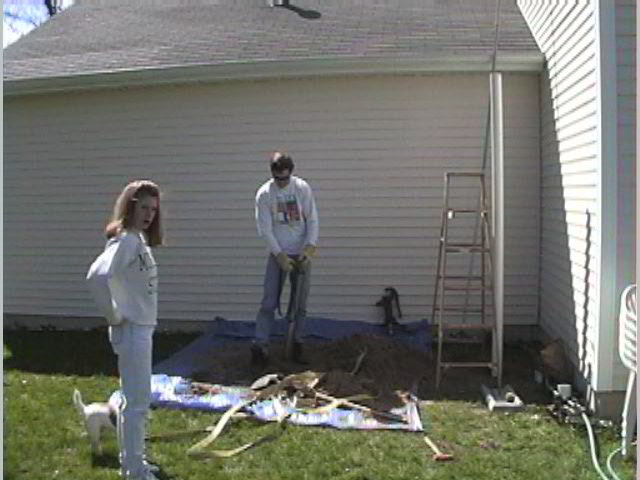
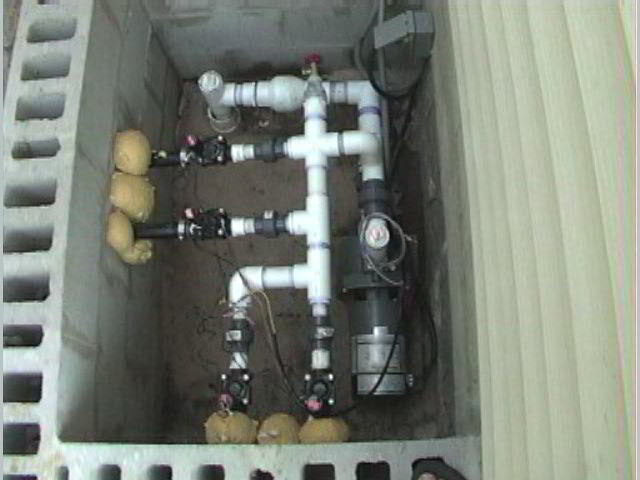
WARNING: PVC drivepoints can shatter when hit with a hammer.
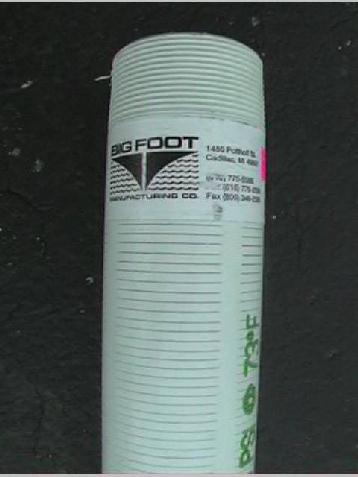
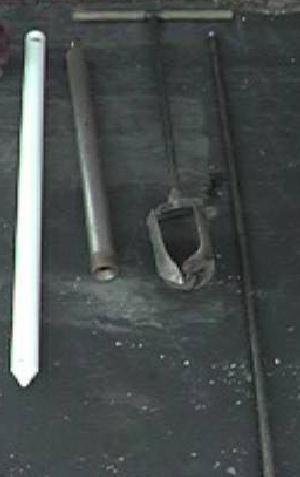
Fascinating isn't it? If you have access to a machine shop, you can build your own sandsucker by following Phil's diagram:
